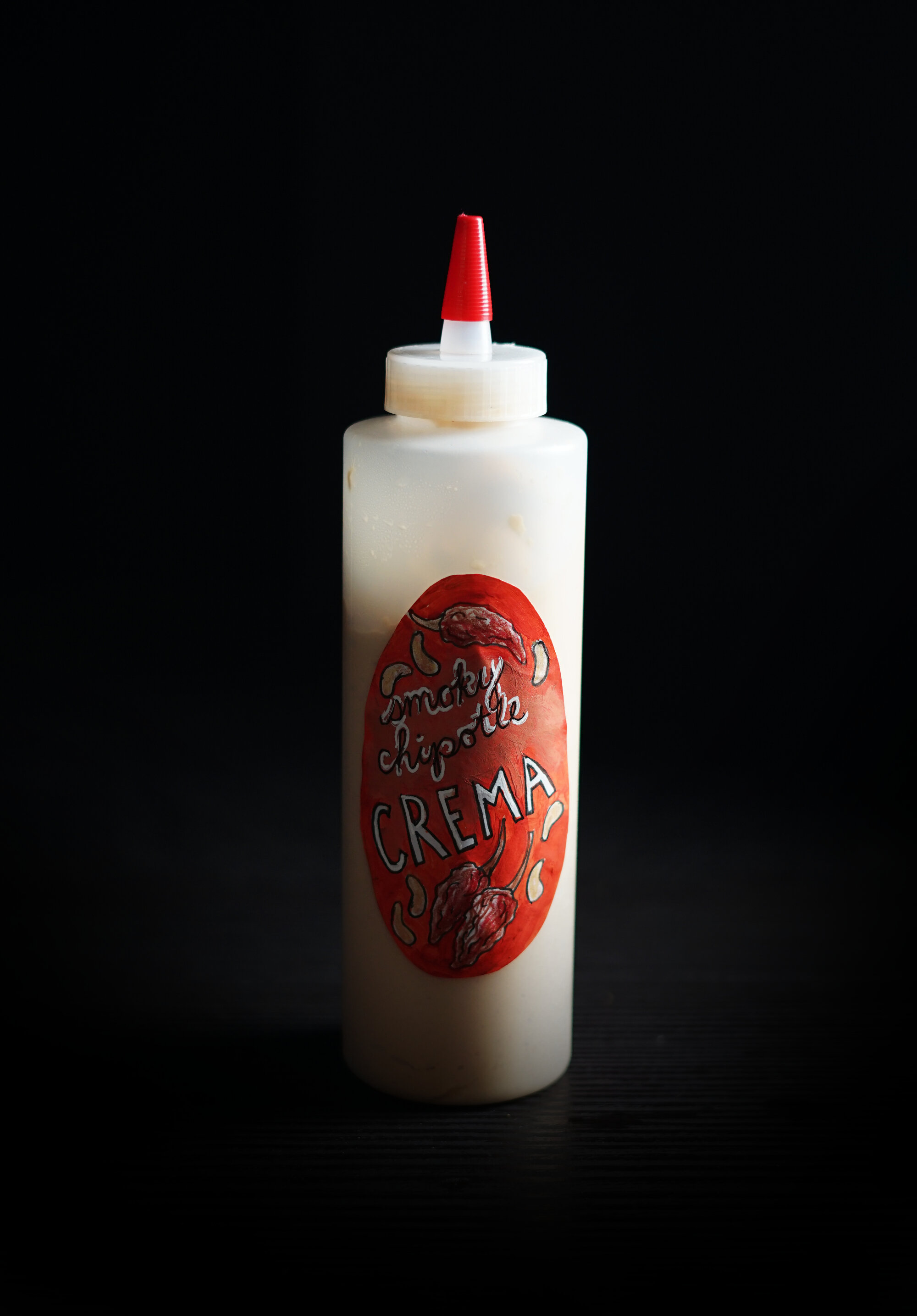Gourmet Carrot Dogs with Wildcrafted Condiments (Bountiful Urban Foraging)
New to foraging? Learn more about ethical and safe foraging (plus how to get started) here!
As a mountain girl now living in a city, I have the uncanny ability to see food absolutely everywhere, and the awkward impulse to wander into stranger’s yards in pursuit of weeds. (Don’t worry, I have enough self-control to wait until I have permission for that. ;) Walks around my neighborhood in the summertime leave me astounded with how much nutritious and tasty edible food goes to waste, simply because of the biases that accompany it. Many of the most common garden weeds are edible; and yet they are destined for the compost (or worse, sprayed with herbicides) simply because they are “weeds.” As an urban forager, you can bet that I know where the vacant lot full of purslane is, or what plum trees have the biggest mess underneath them in summer’s heat. I’ve written letters, knocked on doors, and brought my extroverted friend along with me to obtain permission to grab a few weeds from a neighbor’s garden. I’ve explored the local community garden, knowing that harvesting the weeds growing in the vegetable patches will be seen as an act of service to the garden while also providing me with something tasty to eat! I know the edges, the public spaces, the kind neighbors, the hidden gems.
Another reason most people don’t mess with these free sources of food is because they tend to be a little more labor-intensive than the more accessible foods that can be purchased at the grocery store. It’s true that processing foraged foods can take time and patience, but it’s something that keeps my hands busy while my mind is free to wander, talk to a friend, or listen to an audiobook. Sometimes I set all the distractions behind and get lost in the flow state of sorting wild mustard seeds or de-pitting plums. Not all foraged foods need much processing, either. Purslane is delicious just rinsed and eaten in a salad! A crock pot does the work of reducing apricots to a thick sauce. A food processor makes grinding greens into pesto a simple task. Not all wild food takes time to process into something edible and delicious!
Lately, my evening wanders around the neighborhood have been accompanied by that quintessential summertime fragrance: the backyard bbq. The smell of smoke and charcoal, hotdogs and hamburgers, drifts from block to block, leaving me hungry by the time I return home. And once a craving settles into my mind, it’s hard to let go of it until I make and eat it!
Ever since I watched Antoni Porowski make gourmet hot dogs in the show “Queer Eye,” my normal toppings of brown mustard and relish have felt a little… lackluster. Hot dogs are such down-to-earth food, amazing at casual bbq’s or when out camping! But it’s awfully fun to take them to a whole other level. In this post, you’ll find recipes for a vegan umami broth that can then act as a marinade to transform carrots into delicious stand-ins for hot dogs. I’ve also included recipes for wildcrafted condiments. This post is very much a “take what you want” kind of post. I love the carrot dogs with my homemade condiments, but there’s no reason you can’t just stick to the classics on your carrot dog or (if you aren’t vegetarian) dress up a normal hot dog with some fantastic new flavors. Take what you will, the important thing here is to create enjoyable food! Keep in mind, too, that the condiments can be made ahead of time since the flavors continue to mellow and develop in the fridge.
I’ve been seeing recipes for carrot dogs all over the Internet these days, and for good reason. They are a wholesome substitution for other vegetarian or vegan hotdog substitutions, which often contain long lists of not-so-nice ingredients. If you are expecting a perfect copy of a hot dog, this isn’t it. But if you’re looking for something savory and tasty to enjoy at the next BBQ that is wonderful in its own right, give em a try! The trick is marinating the carrots overnight so they take on lots of rich umami flavor from a versatile broth. They are not an exact replacement for the taste and texture of hot dogs, but they are delicious!
Plant-Based Magic Umami Broth
This broth mixture has a huge depth of flavor, and has been really helpful to me in coming up with flavorful vegan or vegetarian recipes that still meet those umami cravings. Use it as a marinade, cook it down into a sauce, or add it to soups or dips for extra flavor.
Ingredients:
1 Tbs. olive oil
2 cloves garlic, chopped
2 c. water or vegetable broth
¼ c. dried wild mushrooms, such as boletes or lion’s mane
2 tsp. Dulse seaweed
⅔ c. ponzu sauce
2 Tbs. brine from pickled walnuts (or vegan worcestershire sauce)
2 tsp. Liquid smoke
2 Tbs. sweet white miso
1 Tbs. peanut butter
Directions:
Heat a medium saucepan over medium heat. Add the olive oil and then the garlic and cook, stirring frequently, until the garlic is fragrant. Add the wild mushrooms, broth, and dulse seaweed and bring to a boil.
Boil for 10 minutes, then reduce to a simmer until the liquid has reduced by half (you should have about 1 c. of broth.) Strain out the mushrooms and seaweed and pour the broth back into the pot.
Add the rest of the ingredients and stir over low heat until everything is completely combined. At this point you can remove the mixture from the heat and store covered in the fridge, or add in additional ingredients for a recipe like the recipe below:
Carrot Dogs:
8 large carrots
1 recipe umami broth, above
1 Tbs. maple syrup
2 tsp. Paprika
½ tsp. Mustard powder
2 cloves garlic, finely minced
Olive oil, to brush
Toppings:
8 vegan hotdog buns
Purslane relish (below)
Wild mustard mustard (below)
Wild plum ketchup (below)
Chipotle cream (below)
Caramelized onions
Crushed potato chips
Fresh cilantro leaves
Anything else that sounds good! (see below for lots more ideas.)
Directions:
Peel the carrots, then cut them to the length of a hotdog. Carefully use a knife to round the ends.
Add the maple syrup, paprika, mustard powder, and garlic to the saucepan full of umami sauce. Bring to a boil, then simmer for 5 minutes.
Place the carrots in a deep roasting pan. Pour the hot marinade over the top, then cover with aluminum foil. Let sit for about 1-2 hours.
Preheat oven to 425F. When it’s hot, put the covered pan in the oven and roast for 10 minutes, then flip over the carrots and roast for another 20 minutes. Remove from oven and let the carrots sit in the marinade until it’s time to grill, at least one hour or overnight.
Remove the carrots from the marinade and brush them with olive oil. Grill over medium-high heat for 5-10 minutes, turning every few minutes. The carrots should be tender but not mushy.
Toast the buns, then serve the carrot dogs hot with your chosen accompaniments.
Pickled Purslane Relish:
I honestly have such a hard time picturing purslane as a weed. The plant itself is beautiful, with reddish stems and teardrop-shaped succulent leaves. It grows in the most challenging conditions - in compacted soil, in areas of immense heat and little water, even up through sidewalk cracks. It has a pleasant lemony flavor and delightful crunch. While I am perfectly happy to eat purslane all on its own, it also makes a great ingredient for recipes such as this one. Make sure that you forage your purslane from a clean area and wash it well! If the stems are still tender, use those; otherwise, stick to leaves only so your relish doesn’t have any tough textures. This is a sweet-style relish; for extra flavor you could also add a little dill and/or cut down on the sugar to taste. Also keep in mind that purslane is mucilaginous, like okra. The mixture will be slimy before letting it sit with salt and then rinsing it! The resulting relish has a little thicker texture than most commercial relishes do. I personally love it, but if you don’t like things like okra, it might not be for you.
Ingredients:
2 c. chopped purslane leaves and tender stems
1 medium cucumber
1 large shallot
1 Tbs. Sea salt
1 tsp. Cornstarch
½ c. apple cider vinegar
½ c. sugar
½ tsp. Celery seed
¼ tsp. Ground mustard
¼ tsp. Turmeric
Directions:
Slice off the ends of the cucumber and then slice in half lengthwise. Scoop out the seeds in the middle, then chop the cucumbers very finely.
Chop up the shallot into small pieces as well, then mix together the purslane, cucumber, and shallots.
Add 1 Tbs. of sea salt to the veggies and mix it in with your clean hands. (This helps to draw out the moisture of the vegetables.) Cover the bowl and leave it in the fridge overnight.
The next day, dump the mixture into a fine mesh strainer over the sink. Rinse well. Squeeze well to remove as much moisture as possible. Tip: save the gloopy liquid that gets rinsed out! It’s wonderful added to a bath for a silky bathing experience that soothes sunburned skin!
Add the apple cider vinegar and the cornstarch to a small saucepan. Whisk well, then start heating over medium heat. Add the sugar and spices and continue to whisk as the mixture heats up. Once the mixture is boiling, add the vegetables and turn the temperature down to low.
Simmer for 10 minutes, stirring often. Pour the finished relish into sterilized glass jars and store in the fridge for up to three months.
Wild mustard mustard
‘Wild’ mustard is a bit of a misnomer. It probably should be called ‘feral’ mustard, since wild mustard is just escaped domestic mustard that is growing where it “shouldn’t be.” It is considered an invasive weed in many areas, so using it in recipes like this one is a great way to tend to your landscape while also enjoying the seeds of your labor. I harvest wild mustard seeds as soon as the seedpods are starting to turn golden in late summer. I cut full stalks (or even dig up the root to help with management of its invasive nature), then lay the whole plant out on a big sheet to continue drying. Once it’s completely dry, it’s easy to open the little pods and save the seeds within. (A great activity to do with a friend or while watching a movie since it is mindless but monotonous work.) To me, this mustard tastes extra special knowing the careful effort I put into it! You could, of course, just purchase mustard seeds if you don’t want to try foraging your own. Fresh mustard flowers also add a fun element, and thyme and beer give it lots of flavor. This mustard will be quite hot at first; it’s best to make it a week or two in advance and let it mellow in the fridge for a while!
Ingredients:
¾ c. wild mustard seeds
½ c. water (or beer, for extra flavor)
½ c. apple cider vinegar
¼ c. fresh lemon juice
2 Tbs. honey
1 Tbs. dried mustard powder
2 tsp. Sea salt
1 tsp. Garlic powder
1 tsp. Turmeric
1 Tbs. Finely chopped tarragon or thyme
Directions:
Place the wild mustard seeds in a clean jar with the water and vinegar. Cover and refrigerate overnight.
Pour the seed mixture into a blender and add the rest of the ingredients. Puree to desired consistency (I like to keep some texture in mine!) Add a little more vinegar, lemon juice, or water as needed to blend it into a paste. Adjust seasonings as needed. Store in an airtight container in the fridge for up to 2 months.
Easy Plum and Tomato Ketchup
The city I live in is full of ornamental plum trees. They are so beautiful in the spring, with their fragrant blossoms perfuming the breeze! But come summertime, those trees turn into overladen fruit-dripping sidewalk hazards. As a forager, it breaks my heart to see so much fruit go to waste! These little plums might not be fantastic for eating, but they still have a lovely flavor and lots of versatility. I love adding them to sauces or ketchup, and I’ve found that most neighbors are overjoyed to have someone helping to clean up their plum tree mess! Just make sure that you have permission to gather and that you use plums that are as clean as possible.
Ingredients:
2 pounds wild plums, de-pitted and chopped
¼ c. apple cider vinegar
1 (6 oz) can tomato paste
⅓ c. sugar
2 tsp. Sea salt
½ tsp. Allspice powder
½ tsp. Onion powder
½ tsp. paprika
1 clove garlic, minced
½ tsp. Cornstarch whisked into 1 Tbs. water
Directions:
Add the plums to a crock pot with just a little bit of water. Set on low and let cook overnight. In the morning, the plums should be soft and liquid. Pass this mixture through a ricer or just toss it into the blender and puree until completely smooth. You’ll need 2 ½ c. plum puree for this recipe.
Add the plum puree and the rest of the ingredients to a high-speed blender and blend until very smooth.
Pour the mixture into a crockpot on “low” and let cook for a few more hours, checking and stirring every half hour or so, until the mixture has thickened to the texture of ketchup. Store in the fridge for up to a month.
Chipotle Cream Sauce:
This recipe isn’t foraged, but it is too delicious not to include. I absolutely love the flavor of chipotles in adobo sauce, and the creaminess of cashews helps to temper the heat a bit. Just make sure you have time to soak your cashews overnight!
Ingredients:
1 c. raw cashews
2 Tbs. lemon juice
2 Tbs. water
1 small can chipotle peppers in adobo sauce
Salt to taste
Directions:
Soak the cashews in water overnight (keep refrigerated), then strain well. Add to a food processor along with the lemon juice, water, and 1 Tbs. adobo sauce from the chipotle pepper can. Blend until creamy. Taste, and add salt to taste and more adobo sauce if you enjoy more heat. Store in the fridge in an airtight container for up to 1 month.
Other toppings recommended by friends:
It turns out that there is no limit to what you can pile on top of a hot dog, vegan or otherwise. Here are some suggestions I’ve compiled, which range from obvious to quite strange. Get as wild and creative as you’d like:
Honey mustard
Saurkraut
Crushed potato chips
Chipotle mayo
Dill pickle spears
Ranch dressing
Buffalo sauce
Chives
Bacon
Guacamole
Corn
Cilantro
Caramelized onions
Cheese - cheddar, goat, cojita, bleu, nacho cheese…
Grilled pineapple
Bbq sauce
Mac and cheese
Slaw
Chip dips
Diced onion or shallots
Pickled or candied jalapenos
Horseradish cream
Chili
Sriracha
Kimchi
Peanut butter and grape jelly (she swears it is delicious)
Baked beans
Fresh jalapenos
Seaweed crumbles
Fry sauce
Pineapple sauce
Chutney
Pickled vegetables
Pesto
Roasted bell peppers
...as you can see, the sky is the limit!
Love what you’ve read here? Don’t forget to Subscribe to get frequent updates of new posts!
Huge thanks to my Patrons that make sharing all of these lovely posts with you possible (without all of the pop-ups and ads that make browsing other blogs so annoying). If you’re feeling generous, you too can support the wonder with a monthly contribution of your choice. Even $1 helps a lot! Your donation will help to fund this blog as well as my surprise free events and gifts for strangers. Learn more about this program at the link below:

























Join me for a little winter night magic as we bake this cake full of rich seasonal flavors and black cocoa!